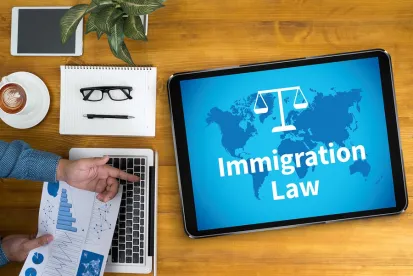On Jan. 25, 2017, President Donald J. Trump signed two Executive Orders impacting U.S. immigration which are summarized below.
Executive Order: Border Security and Immigration Enforcement Improvements
This Order addresses the recent surge of immigration by foreign nationals without proper documentation at the United States’ southern border with Mexico. The Order directs the government’s “executive departments and agencies to deploy all lawful means to secure the Nation’s southern border, to prevent further illegal immigration into the United States, and to repatriate illegal aliens swiftly, consistently, and humanely.”
Specifically, the Order implements a policy to secure the southern border through the “immediate construction of a physical wall on the southern border…” The Order goes on to define “wall” as “a contiguous, physical wall or other similarly secure, contiguous, and impassable physical barrier.” The Order itself instructs the Department of Homeland Security (DHS) Secretary to identify and allocate all sources of federal funds and to project and develop long-term funding requirements for the wall.
This Order also mandates the DHS Secretary to ensure the detention of undocumented foreign nationals apprehended for violating immigration law pending the outcome of their removal proceedings. It calls for action and fund allocation for new detention facilities at or near the Mexico border. Additionally, the Order commands the prompt removal of individuals whose legal claims to remain in the United States have been lawfully rejected after any appropriate civil or criminal sanctions have been imposed. In particular, the policy known as “catch and release,” whereby undocumented foreign nationals are released in the United States shortly after their apprehension for violating immigration law, is terminated. Subject to funding, an additional 5,000 Customs and Border Protection Border Patrol agents will be hired to execute new detention protocols.
In addition, the Order also establishes a policy “to end the abuse of parole and asylum provisions currently used to prevent the lawful removal of removable aliens.” The text of the Order indicates that immigration law has thus far been “exploited to prevent the removal of otherwise removable aliens.” It calls for more training of DHS personnel. In fact, new policy guidance in line with the Order is expected to be issued soon to all DHS personnel regarding the detention of undocumented immigrants.
The Department of Homeland Security Secretary and the U.S. Attorney General are expected to submit to the president a progress report on this Order’s directives within 90 days and 180 days, respectively.
Executive Order: Enhancing Public Safety in the Interior of the United States
This Order addresses unlawful immigration’s potential effects on U.S. national security and public safety. In particular, it states “Many aliens who illegally enter the United States and those who overstay or otherwise violate the terms of their visas present a significant threat… This is particularly so for aliens who engage in criminal conduct in the United States.” The Order also states “Many of these aliens are criminals who have served time in our Federal, State, and local jails.”
To improve the country’s security and safety, the Order seeks to impose the “faithful execution” of U.S. immigration laws by executive agencies. In doing so, the executive branch will ensure that “sanctuary jurisdictions” do not receive federal funds (except as mandated by law) if they fail to comply with applicable federal law. Generally in these jurisdictions (also known as “sanctuary cities”), undocumented immigrants are not prosecuted for lacking the proper immigration status. The Order states that the practice of “shield[ing] aliens from removal… [has] caused immeasurable harm to the American people…” and requires a comprehensive list of criminal actions committed by aliens and any jurisdiction that ignored or otherwise failed to honor any detainers with respect to such aliens, publicly published on a weekly basis. Following the Executive Order, representatives of several sanctuary cities stated they will remain as such, including New York City, Chicago, San Francisco, Los Angeles, Philadelphia, and Seattle.
The Order further calls for the enforcement of immigration laws, prioritizing removable aliens who have been convicted of or charged with criminal offenses. Subject to funding and law, an additional 10,000 Immigration and Customs Enforcement officers will be hired to carry out the enforcement. At the press conference, Press Secretary Spicer indicated that other enforcement tools would include withholding visas from countries to ensure they accept their nationals back following removal from the United States.
This Executive Order also encourages sanctions against countries that deny or unreasonably delay accepting a deportable national of that country. This could result in the discontinuation of granting immigrant and/or nonimmigrant visas to residents of that country. A blanket discontinuance of visa issuance could result in reciprocal treatment against U.S. visa applicants. To date, the U.S. government has identified 23 such countries, including China and India.
In addition, this Order calls for the reinstitution of the Secure Communities “SCOMM” program, whereby arrestees’ fingerprints are submitted to both criminal and immigration databases to facilitate their removal where appropriate. SCOMM’s reinstitution terminates the Priority Enforcement Program, which had replaced the original Secure Communities program in July 2015. To further address Americans’ public interest, the Order directs the establishment within ICE of an office to provide “proactive, timely, adequate, and professional services to victims [and their family members] of crimes committed by removable aliens.” The office is required to provide quarterly reports on the “effects of victimization by criminal aliens present in the United States.”
Both the Department of Homeland Security Secretary and the U.S. Attorney General are expected to submit to the President a progress report on this Order’s directives within 90 days and then again within 180 days.
It is expected that there will be additional immigration-related Executive Orders addressing DACA (Deferred Action for Childhood Arrivals), restricting immigration from certain Muslim-majority countries deemed to be a national security risk, and a review of legal immigration procedures and visa categories.


 />i
/>i

